Sir Archibald
Henry Bodkin, KCB (1862–1957) was our British Director of Public
Prosecutions from 1920 to 1930. He particularly took a stand against the
publication of what he saw as ‘obscene’ literature.
In the 1920s he tried
to ban Ulysses by James Joyce and even threatened in 1922 to prosecute
the academic F. R. Leavis if he mentioned it in his lectures at Cambridge
University since it contained “a great deal of unmitigated filth and
obscenity”. On December 29, 1922 he banned the book, saying “As might be
supposed I have not had the time, nor may I add the inclination to read through
this book. I have, however, read pages 690 to 732.” He also stated he could
not make “head nor tail” of the book. The British ban remained until
1936.
For those unfamiliar with this expression, according to The Free
Dictionary, Neither head nor
tail means
neither beginning nor end; neither this thing nor that;
nothing distinct or definite; – a phrase used in speaking of what is indefinite
or confused; as, “they made neither head nor tail of the
matter”
However, if one wants to find a most graphic application of
this phrase, there is none finer to be found anywhere than the developmental
biology of the echinoderms, to wit the
starfish and their relatives.
Among the unsung heroes of 19th
century zoology, there must have been many microscopists who strained their eyes
studying the larvae of marine organisms. Many molluscs and crustaceans in
particular were found to go through one or more episodes of metamorphosis from
the newly hatched larva to their adult forms. But out of all of these, the
echinoderms must, I think, take the group prize.
Here, for example, are
some stages in the development of the Crown of Thorns
Starfish, that causes so much damage on coral reefs.
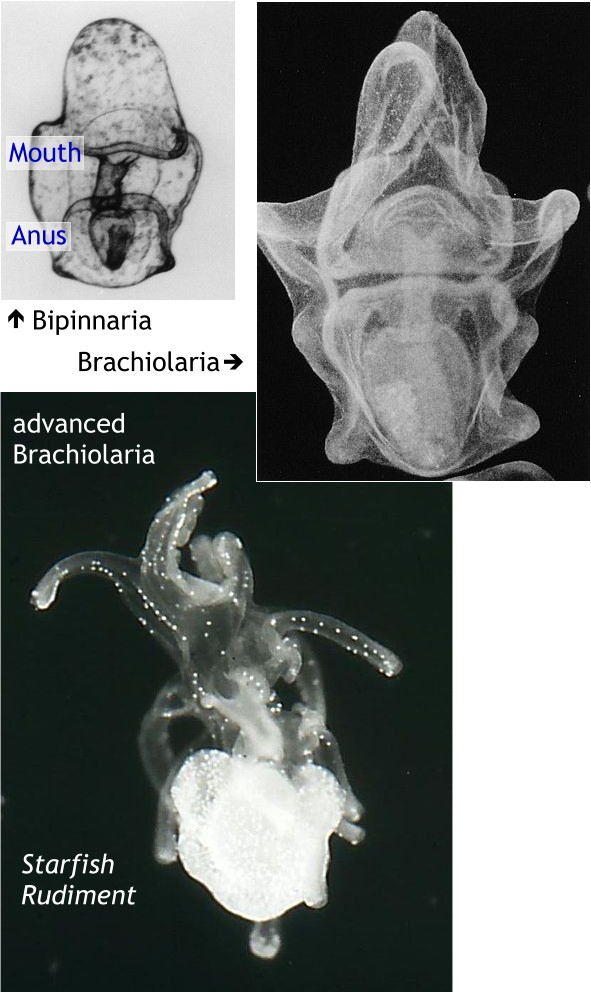
The
accompanying text, from Wikipedia: «By Day 1 the embryo has hatched as a
ciliated gastrula stage. By Day 2 the gut is complete and the larva is now
known as a bipinnaria (top left). It has ciliated bands along the body and uses
these to swim and filter feed on microscopic particles, particularly unicellular
green flagellates (phytoplankton). By Day 5 it is an early brachiolaria larva
(top right). The arms of the bipinnaria have further elongated, there are two
stump-like projections in the anterior (not evident in the photograph) and
structures are developing within the posterior of the larva. In the late
brachiolaria larva (Day 11)(bottom) the larval arms are elongate and there are
three distinctive arms at the anterior with small structures on their inner
surfaces. To this stage the larva has been virtually transparent, but the
posterior section is now opaque with the initial development of a starfish. The
late brachiolaria is 1-1.5 mm. It tends to sink to the bottom and test the
substrate with its brachiolar arms, including flexing the anterior body to
orient the brachiolar arms against the substrate.»
So far, so good.
Other creatures also settle down with their front ends attached. Barnacles are
crustaceans, and their life-cycle has been described thus “A barnacle has been
described as an animal that sits on its head and kicks food into its mouth with
its feet.” The larvae of many tunicates (sea squirts) also attach themselves by
adhesive spots on their front end and absorb their cerebral ganglia. As for our
starfish:
«The late brachiolaria search substrates with their arms
and, when offered a choice of substrates, tend to settle on coralline algae,
which they will subsequently feed on. In the classic pattern for echinoderms,
the bilaterally symmetrical larva is replaced by a pentamerously symmetrical
stage at metamorphosis, with the latter’s body axis bearing no relationship to
that of the larva. Thus the newly metamorphosed starfish are five-armed and are
0.4–1 mm diameter.»
This is a somewhat limited account of the
process. Referring
this time to Living Invertebrates:
«The final stages of metamorphosis are completed rather rapidly. A new mouth breaks through on the larval left side through the middle of the ring canal, while a new anus opens on the larval right side, thus producing an adult axis at right angles to the larval axis. The 5 radial canals grow out and develop tube feet, the body takes on the adult shape, and the young sea star crawls away to a new life.»
The starfish, however, form
but one of the five extant groups of echinoderms. Here are all five, presented
in a cladogram from University of California, Berkeley:
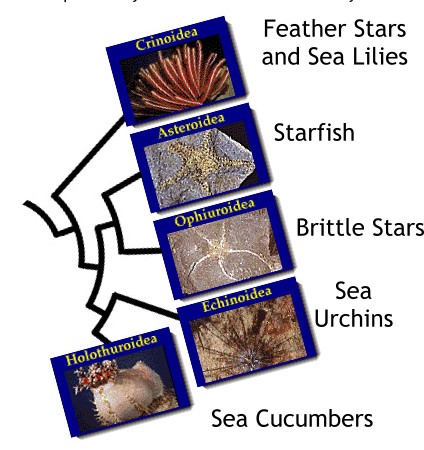
At the top we see
the Crinoidea, or sea lilies. These are the Pelmatozoa, or stalked
animals, even though the feather stars during their development leave their
stalk behind and wander off freely.
The other four classes form the
Eleutherozoa, or free-living animals. Working out the relationship
between the four classes seemed well-nigh impossible, until molecular biology
came along and allowed them to be grouped in two sets of two, as in the
cladogram. Easy enough, you may think, until their larval development is
compared.
Here is part of a diagram from Echinoderms by David
Nichols (1962). It shows the larval development of the four classes, but I have
picked out the starfish or Asteroidea (left) and the sea cucumbers or
Holothuroidea (right).
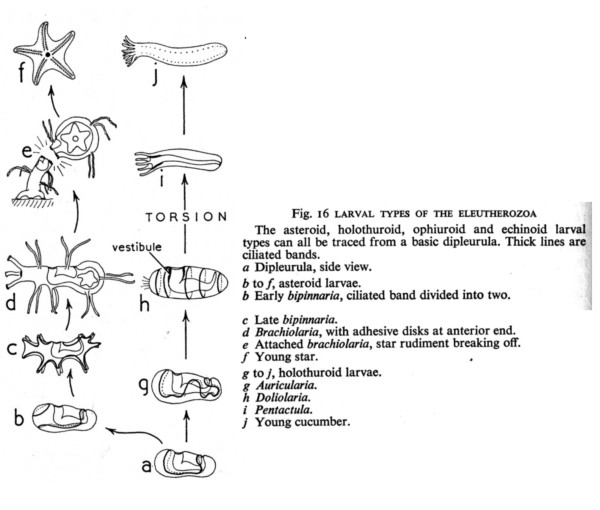
At e in the left-hand column, we see the star
rudiment with the developing starfish mouth breaking off, and leaving behind the
larval front end with its larval mouth (or else the larval body may be
absorbed.) However, with the sea cucumber, there is a bit or torsion of the
internal organs, but it keeps its larval mouth, even though the internal vessels
of the little animal are growing into the five-fold symmetrical pattern in a
manner quite similar to the starfish. But most of the adult sea cucumber’s body
is developed from larval tissue.
To make matters worse, the other two
classes, namely brittle stars, develop via pluteus larvae, (pluteus meaning
“easel”) which have extra arms compared to the other two. Here is an example of
an echinopluteus larva of a sea
urchin.
Here is a table summarizing these differences:
|
Class |
Which mouth? |
Pluteus? |
|
Starfish |
New mouth |
|
|
Brittle Stars |
Larval mouth |
Pluteus |
|
Sea Urchins |
New mouth |
Pluteus |
|
Sea Cucumbers |
Larval mouth |
|
Seeing how these features
fit in with the molecular picture shows that trying to work out a consistent
evolutionary plan from the larval morphological development could lead nowhere,
almost as if it had been designed with the specific purpose of driving
evolutionary developmental biologists mad.
From Bilateral to Pentradial
Many “primitive” creatures
like cnidarians (jellyfish, sea anemones, etc.) are radial, while a majority
“higher” creatures are bilateral, with a left and right side, a top and a
bottom, and a front-to-rear axis. Sometimes this symmetry is broken, as in
snails with their spiral shells, but in development they start out bilateral,
and twist, but some organs on one side may not develop.
The development
of larval forms of echinoderms (starfishes, sea urchins, etc) starts out
bilateral, and the radial form develops by metamorphosis. In the later
19th century there developed the theory of
recapitulation, also called the biogenetic law or embryological
parallelism— often expressed in Ernst Haeckel’s phrase as “ontogeny
recapitulates phylogeny. This now largely discredited biological hypothesis
states that in developing from embryo to adult, animals go through stages
resembling or representing successive stages in the evolution of their remote
ancestors. «Embryos do reflect the course of evolution, but that course is far
more intricate and quirky than Haeckel claimed. Different parts of the same
embryo can even evolve in different directions» (University
of California Museum of Paleontology).
Even so, in echinoderms
the course of larval development is overwhelmingly strong that the remote
ancestor of the echinoderms was bilateral.
The early Cambrian has yielded
many strangely shaped echinoderms, which look as if they were half-way between a
bilateral and a radial state. Now, within the last year or so, the two ends of
the sequence between bilateral and pentaradial have been discovered in the
fossil record.
The first thing that the Natural History Museum in London
brings to mind is most probably dinosaurs, though as I walked round the gallery
with a Mesozoic scene I was looking rather at the vegetation. But for years
there has been a very active group, headed by Dr Andrew Smith, working on
echinoderm fossils from all over the world, who have discovered
two new creatures at each end of the development.
First, from Spain,
comes this bilateral creature Ctenoimbricata spinosa, published in 2012
[1]. A bilateral echinoderm Courtessolea moncereti was known since 1999
from a rather damaged specimen, but a more complete one has also turned up. But
Ctenoimbricata also seems to represent a more primitive version of this
body plan. 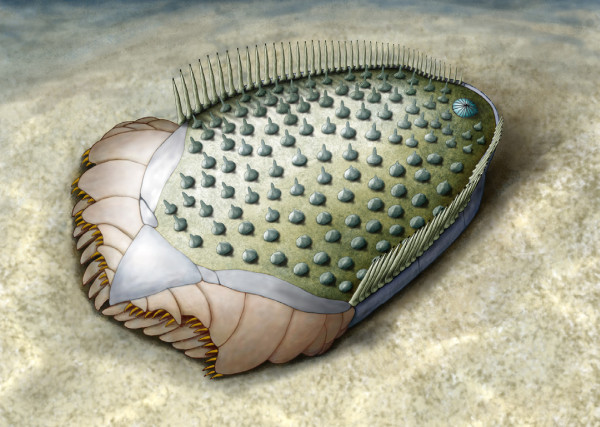
Secondly, this year we have the (so far) earliest
known pentaradial echinoderm, Helicocystis moroccoensis (from guess
where!) [2]
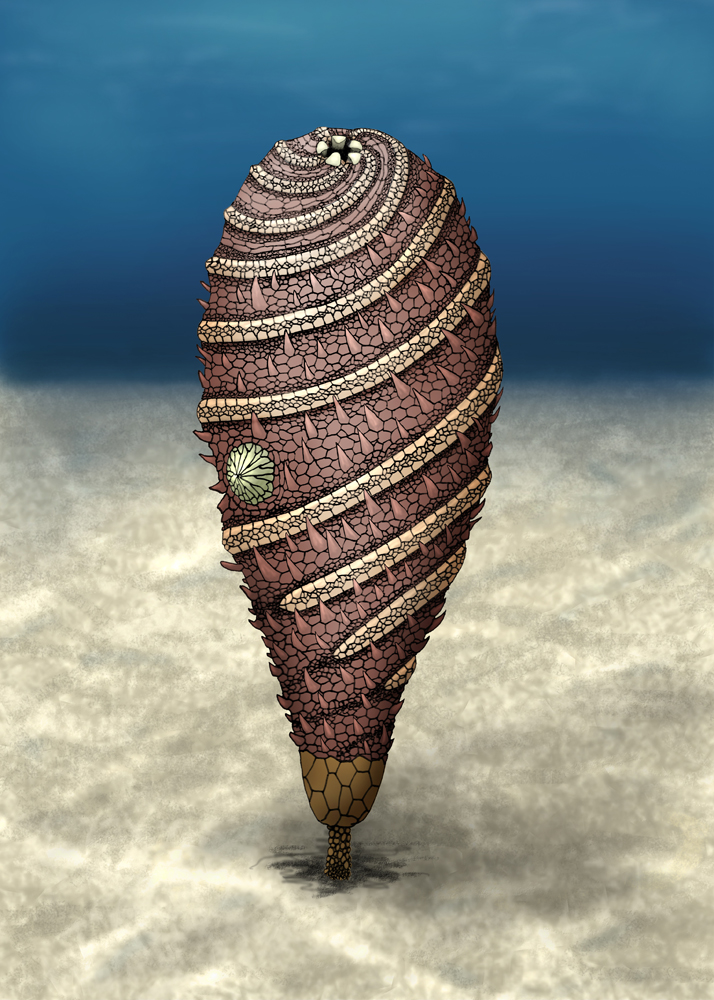
Here is part of a figure from [2] showing a progression
from the bilateral to the pentaradial form
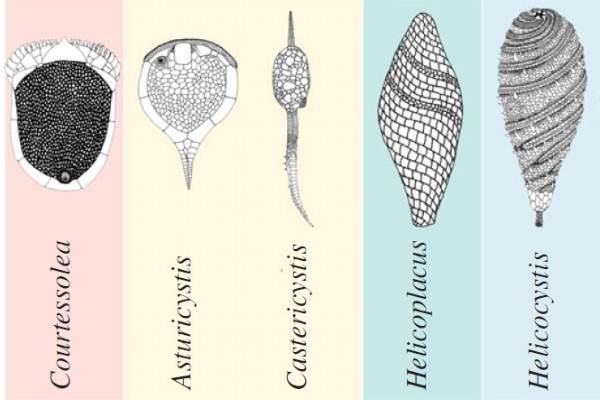
Furthermore, the new
pentaradial specimen seems to sit nicely as an ancestral form. So, what shall
we call this creature? Let us give it fine sounding German
name:
der
Urfünfzähligsternförmigstachelhäuter
(meaning the original
five-numbered star-shaped prickly-skin!)
But whatever you call it, I have
complete sympathy for anyone who says they can’t make head nor tail of
starfish!
====================================================================
1] Title: Plated Cambrian Bilaterians Reveal the Earliest Stages of
Echinoderm Evolution
Author(s): Zamora, Samuel; Rahman, Imran A.; Smith,
Andrew B.
Source: PLOS ONE Volume: 7 Issue: 6 Article Number: e38296
DOI: 10.1371/journal.pone.0038296 Published: JUN 6 2012
[2] Smith
AB, Zamora S. 2013
Cambrian spiral-plated echinoderms from Gondwana reveal
the earliest pentaradial body plan. Proc R Soc B 280:
20131197.





Comments